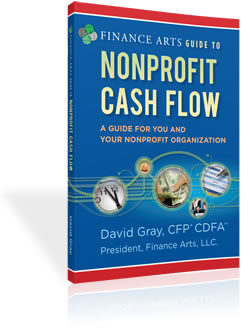Introduction by Wendy Liscow, Program Officer
“Our goal is the success of our grantees.”
This is how one of our board members recently summarized Dodge’s investment in technical assistance and capacity building for our grantees. Many of you have already registered for our current Board Leadership Training series, but if you haven’t already, register now. Today’s guest blogger, David Gray, is one of the many consultants working with our grantees who attended our Board Training series and were then eligible to apply for a matching board capacity building grant. David has a lot to say on the topic of financial management for nonprofits, and his new book is arrives in stores today. We thought you would appreciate a taste of his wisdom.

David Gray
President, Finance Arts, LLC
With increasing focus in the nonprofit sector on the broad concept of sustainability, many organizations are struggling with determining just what sustainability means. Does sustainability mean, “How do we stay in business?” Does it mean, “How do we ensure we have enough money to keep doing what we are doing?” Does it mean, “How do I stay in business without counting on the continuing support of fickle foundations?”
Before you can determine how to become sustainable, by any of these definitions, I believe it is essential to understand your business model, and the annual cash flow that emerges as a result of your business model. I believe this so strongly that I have written a book about it, The Finance Arts Guide To Nonprofit Cash Flow (available at Amazon and other online booksellers).
We don’t tend to think about nonprofit organizations in terms of their business models but every organization has one, whether they know it or not. The business model combines how an organization is capitalized (what kind of financial structure has been used to create and operate it) and how, in most cases, the services we provide are “bought” and paid for. Of course, in many cases, services aren’t “bought” by the end user. Neither a soup kitchen nor an orchestra charges the end user a price that covers the costs of providing the service, so additional funds are required. How we organize this financial picture determines the business model.
In a perfect world everything we do would be paid for in full, and in advance. So we would collect all the funds and then generate the service so that at no time would we be “out of pocket.” In the real world there are few nonprofit organizations that can generate sufficient funds in advance of incurring costs for providing services. Theaters sell subscriptions to get money in advance of providing the service. Private schools try to get tuition in advance for the same reason. But even these organizations must raise additional funds and it is very difficult to do so in advance of the theater season or school year.
Your business model also determines your annual cash flow. Imagine that you are a florist. You need to have lots of flowers on hand for Valentine’s Day but you don’t really know how many, and people don’t tend to buy them in advance. So you have to pay for the flowers in the hopes that you sell them on Valentine’s Day. You need to come up with substantial money in advance. Many businesses maintain lines of credit with banks for just such purposes.
This contrasts with the busy spring wedding season when most florists require substantial deposits as part of their contract to provide wedding flowers. Here the florist is at much less risk because they have already got funds from the customer to pay for the flowers in advance.
The cash flow of the nonprofit organization will reflect the business model. Do we get money in advance of providing the service and therefore have relatively stable and positive cash flow? Must we provide the service and wait for months for reimbursement from a government agency, reflecting an ongoing cash shortage? Of course small and even medium sized nonprofits may have trouble getting lines of credit so it makes sense to have money saved and set aside for such times.
You can’t address making your organization sustainable, by most any definition, without understanding what your business model is and how that model is reflected in your cash flow. Once you do have an understanding of your business model and its commensurate cash flow, you can then determine whether a line of credit, a cash reserve, an endowment, or some combination of these will provide the most effective route toward sustainability
•
David Gray is President of Finance Arts, LLC, which provides personal financial planning and nonprofit consulting services. Gray, who is a Certified Financial Planner and Certified Divorce Financial Analyst, has also served as Executive Director of nonprofit organizations. His book, The Finance Arts Guide to Nonprofit Cash Flow, is a user friendly guide to understanding nonprofit finance. In the book Gray reviews familiar personal finance topics and explains how they relate to their nonprofit organizational counterparts. Including real-world examples from his own experience, and that of his wife, former New York City Ballet Principal Dancer Kyra Nichols, Gray makes the irregularity of nonprofit cash flow easier to comprehend. Gray also introduces a new method for determining the appropriate cash reserve for nonprofit organizations, based not on outdated rules-of-thumb, but targeted to the specific operational model of the individual organization.
Finance Arts, LLC, located in Princeton, NJ, provides nonprofit consulting and personal financial planning on an hourly fee only basis.
www.FinanceArts.com
dgray@FinanceArts.com
